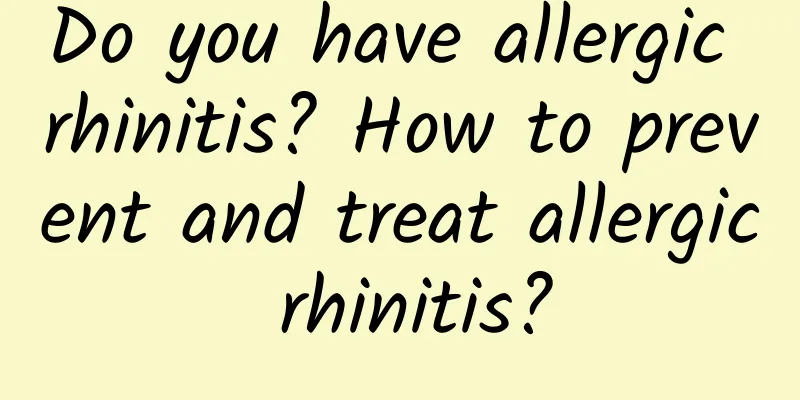Do you have allergic rhinitis? How to prevent and treat allergic rhinitis?

|
What is allergic rhinitis? Allergic rhinitis, formally known as allergic rhinitis, is a group of syndromes characterized by paroxysmal runny nose, nasal congestion, sneezing, nasal itching, coughing, and itching of the eyes, ears, and palate. Long-term allergic rhinitis can cause patients to become irritable and irritable. Allergic rhinitis is a global health problem, with an increasing incidence rate year by year. In Western countries, the prevalence rate is 10% to 20% among adults, and in some developed countries it is as high as 30%. In some central cities in my country, the prevalence rate is about 8% to 20%. It is estimated that more than 100 million people in China suffer from allergic rhinitis. The World Health Organization estimates that approximately 600 million people worldwide suffer from this disease, of which one-third also have asthma[1]. Factors such as air pollution and psychological stress can cause the airway to be in a highly sensitive state, inducing more severe respiratory allergy symptoms. At present, allergic rhinitis is characterized by multiple allergen allergies, long-lasting symptoms and high severity of the disease. More than 90% of patients with this disease are moderate or severe patients, and about 44% of patients with this disease are also accompanied by non-allergic triggering factors, showing mixed rhinitis. Prevention of this disease includes protection, diet, exercise, and medication, among which avoiding contact with allergens is the top priority [1]. The World Health Organization believes that the best way to prevent and treat allergic rhinitis is to block allergens in the environment. Prevention methods: The first is medication, using antihistamines and other blocking drugs 1-2 weeks in advance; the second is to wear a mask. Good protective equipment has five major characteristics: good filtering effect, no suffocation, good sealing, easy cleaning and good safety. Patients should start from these five aspects when selecting protective equipment. The first principle of diet is to avoid allergic foods. Avoid eating raw and cold foods, including cold drinks and salads; avoid eating irritating foods, such as spicy, fried, pickled foods; ensure adequate sleep; patients should also use air conditioning as little as possible and reduce the number of times they go in and out of air-conditioned rooms; relax their body and mind, go outdoors more often to breathe fresh air, and do more exercise to enhance resistance and reduce factors that irritate the nasal mucosa. If you need to use medication, please use it under the guidance of a doctor and do not search the Internet for self-treatment. It should be noted that many patients with allergic rhinitis develop the disease in childhood and will suffer from it throughout their lives. Children's allergic rhinitis should be taken more seriously and prevented. So what are the symptoms of childhood allergic rhinitis that can help us detect it in time? Allergic rhinitis has different symptoms depending on whether it is an acute or chronic allergic reaction. If a child develops a runny nose or sneezes soon after entering a room or touching an object, then it is definitely allergic rhinitis. However, if the child does not develop a reaction immediately after contacting the allergen, but takes several hours or half a day to develop a reaction, then it is also allergic rhinitis. Do not assume that it has nothing to do with allergies if it does not develop immediately. The following are the specific manifestations of allergic rhinitis [2]. Runny nose: After exposure to allergens, runny nose occurs. The runny nose is clear and cannot be stopped. This is a distinctive feature of the runny nose, which is different from the yellow-green runny nose during infection. The runny nose is caused by increased mucus secretion due to allergies. In addition, everyone should pay attention that the runny nose not only flows to the front of the nasal cavity, but also flows to the back of the throat. Paroxysmal sneezing: Allergies cause inflammatory mediators to stimulate the sensory nerves in the nasal mucosa, resulting in sneezing symptoms. If a child sneezes when he touches a certain object, it is probably allergic rhinitis. This type of sneezing is usually very characteristic. Usually, after leaving the allergic environment, there may be no problem at all, but when entering this environment, sneezing occurs. Of course, some children with persistent allergies will continue to sneeze. Nasal congestion: Nasal congestion caused by allergic rhinitis is caused by congestion and edema of the nasal mucosa. In addition, excessive nasal discharge can also cause nasal congestion, which can make children uncomfortable. In severe cases, children can breathe with their mouths open, sleep restlessly at night, and snore. Itchy nose: Itchy nose is a unique manifestation of allergies. It is caused by histamine and it is the itching caused by allergies. After the child has an itchy nose, he may not complain about the itch, but he will often sniff his nose, wrinkle his nose, and rub his nose. Rubbing the nose is called the "allergic salute" - because it is not a real salute. Cough: Coughing may be caused by inflammatory factors caused by allergies stimulating cough receptors; it may also be an irritating cough caused by nasal mucus flowing back into the throat and trachea. In addition, if the cough is caused by nasal mucus flowing back into the throat, it often occurs when the body position changes, especially after getting up in the morning, when changing from lying to standing, the nasal mucus is easy to flow back, causing coughing. Itchy eyes and rubbing eyes: Allergic rhinitis is usually combined with allergic conjunctivitis. If a child is allergic to something, it is impossible for only the nose to show symptoms. The eyes are open every day and connected to the outside world. The conjunctiva is on the surface of the eyeball and is easily exposed to allergens, causing allergic conjunctivitis. The symptoms are that the child's eyeball and inner eyelid are red and watery, and the eyes feel itchy and afraid of light. After a child develops allergic conjunctivitis, he will feel itchy, so he will always rub his eyes. Sensitive reactions to multiple substances: If a child has long-term allergies, there will be persistent inflammation in the nasal mucosa. The persistent inflammation causes the nasal mucosa to increase its sensitivity to external stimuli. The child will have allergic reactions when he smells smoke or is exposed to cold air. Impaired sleep and energy: If a child has severe rhinitis, then the child will have a stuffy nose at night, resulting in insufficient oxygen intake, and the child will not sleep well. Lack of sleep will lead to lack of energy and fatigue during the day. Some children will have a bad temper. Generally, if a child has these symptoms, it is considered to be moderate to severe allergic rhinitis. At what age does allergic rhinitis occur? This disease mostly occurs in children over 2 years old, because allergic rhinitis requires repeated contact with allergens and only appears after several years. Therefore, the incidence of allergic rhinitis is very low in children under 2 years old. If the child has a runny nose, sneezing, or coughing, look for other reasons. However, it is not completely impossible. If the child's allergic symptoms are particularly severe, eczema is repeated and does not heal, and symptoms appear when entering a specific environment, allergic rhinitis should also be considered. The incidence rate gradually increases over the age of 4 years old. Once discovered, it must be treated in time to prevent the child from suffering from lifelong troubles with rhinitis. References: 1. Tang Xu. Prevention of allergic rhinitis is more important than treatment[J]. Health Expo, 2015, 000(012):28-29. 2. Kong Lingkai. Manifestations and prevention of allergic rhinitis in children[J]. Family Services, 2017(08):48-49. |
<<: Coughing and diarrhea may be symptoms of food allergies. Do I need to get tested for allergens?
>>: 8,400 bacteria in one bite? Summer ice watermelon is so toxic?!
Recommend
Woman sleeping with back pain in the middle of the night
Now I feel that I often have a backache, especial...
How long does it usually take to wait for a cesarean section?
Whether it is a caesarean section or a natural bi...
Early pregnancy twins B ultrasound picture
When a woman becomes pregnant, it is a very happy...
What is the reason for the yellowish vaginal discharge?
Normal leucorrhea should be milky white or colorl...
What is the reason for my aunt to come so often?
For women, they have a menstrual period every mon...
Want to eat but dare not eat, do you really understand anorexia?
Author: Li Xueni, Chief Physician, Peking Univers...
What foods are good for women's ovaries?
Women's ovaries are not only responsible for ...
What are the symptoms of hypoxia in pregnant women and fetuses? Is hypoxia in pregnant women and fetuses dangerous?
We all know that after a woman becomes pregnant, ...
Ovulation bleeding ovulation test strip test results
Nowadays, women all know that if they have sex du...
How to design a bedroom balcony? Practical bedroom balcony design and renovation tips
We all know that different types of houses have d...
What to do if you have onychomycosis during breastfeeding
Onychomycosis is a very serious infectious diseas...
What are the symptoms of kidney yang deficiency in women?
Nowadays, most women are under great pressure in ...
Why can't radish and black fungus be eaten together? Benefits of eating black fungus
The taste of fungus is fresh and tender. It conta...
How to take care of yourself when you have abdominal pain during menstruation after uterine curettage?
Uterine curettage, also known as curettage. It is...
How to wear underwear in a healthy way?
A healthy life is what we really want. No matter ...









